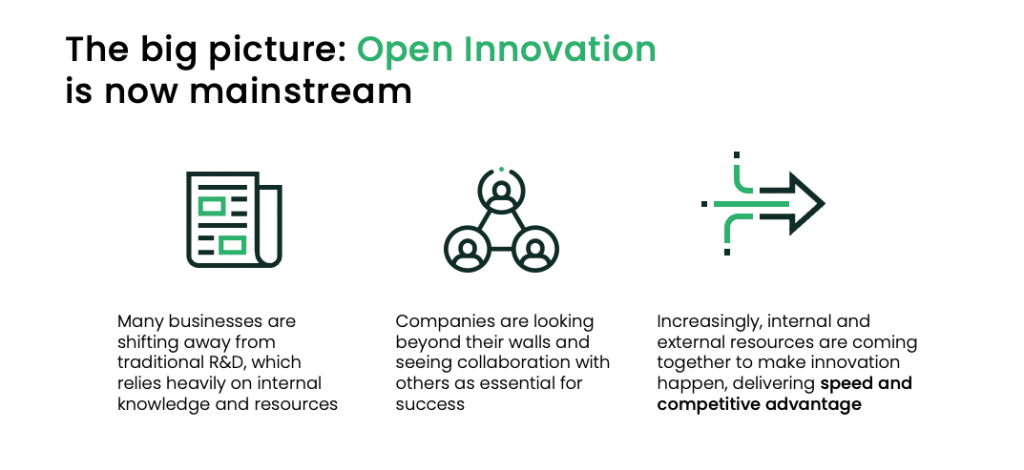Welcome to the Age of Open Innovation
Open source and innovation have been the lifeblood of SUSE for 30 years. While you can certainly have one without the other, they are undoubtedly better together. That’s why I am excited about our collaboration with The Economist on The Open Innovation Barometer. For this survey-based research program, we wanted to find out how openness and innovation work together. We explored the idea of Open Innovation (OI): a democratized approach to innovation where internal and external resources come together to innovate. Innovation is about breaking down barriers and setting yourself apart from the competition. OI takes this further in so many ways — and is what I believe will be a game changer in how we think about innovation for years to come. In this blog post, I’ll share some highlights from our research findings and invite you to challenge your own innovation practices and perceptions through a tool we created to measure your company’s approach to OI.
What is Open Innovation?
We know that innovation sets organizations apart from their competitors – and comes with rewards. Yet a globalized economy and rapid technological transformation have increased the innovation premium and are changing how organizations think about – and practice – innovation.
The idea of Open Innovation (OI) is essentially about breaking from convention. It’s also a bit of a paradox. Despite the idea that competitive advantages are derived through proprietary innovation, we’re seeing organizations embrace the opposite. OI is the concept that no company, regardless of capability or size, can have all the best ideas, knowledge or talent. In OI, we’re seeing the opposite of traditional R&D that relies heavily on internal resources. In OI, internal and external teams come together to make innovation happen.
OI is not a new concept. While the term was coined in 2003 by University of California Berkeley’s Henry Chesbrough, its practice goes back to the days of Thomas Edison’s invention factory in the late 19th century. Furthermore, in the 1950s and 60s, we saw early Internet and networking researchers relying on openness and collaboration – not only in academic settings like Berkeley but in corporate ones such as AT&T’s Bell Laboratories.
Today, OI has entered the mainstream. The Economist Impact survey of 500 senior executives across regions and industries revealed that 95% of organizations are practicing OI in a number of projects. We have entered the age of Open Innovation with a growing number of executives at high-profile companies such as BMW, Nestle and Samsung having titles such as “Manager of Open Innovation.”
OI: Why now?
A host of economic and technological factors are boosting OI adoption. We know that digital technologies lower the cost of collaboration, but they also push organizations to partner in new ways and across sectors. In recent years, we’ve seen agile companies like Netflix and Uber pivot to revolutionize industries. OI fosters that agility. Another factor is the changing nature of capital and labor markets. With more venture capital and an increase in mobile and skilled workers, we’re seeing a rise in OI. Well-established brands, even while continuing their closed R&D models, are beginning to showcase some of their innovation practices in the OI space. Irrespective of a company’s motivations, this research suggests a strong correlation between the application of OI and innovative performance.
It’s impossible to talk about OI without mentioning the COVID-19 pandemic. When innovation was crucial and time was of the essence, companies forged partnerships to address this global health crisis. We saw OI in action from the likes of Pfizer and BioNtech, Ford Motor Company and 3M, and Nike and Oregon Health & Science University, to name a few.
Key findings
It doesn’t surprise me that open source factors highly in OI practices across organizations. I’m thrilled to see that 85% of survey respondents said that open source platforms are important to their success. While 46% said they already use open source software for OI, another 38% plan to join them. In fact, respondents cited open source software as their top OI channel (see infographic for more.)
The research also indicates that OI is gaining momentum, with 91% of respondents reporting increased budgets for OI projects and 85% seeing increased funding for open source software. The bottom line is that OI gives you an edge.
Where are you on your OI journey?
Forward-thinking companies are embracing OI. Is yours? Download the Economist Impact’s Open Innovation Barometer report for key findings and see how your organization compares to others in OI readiness with our self-assessment tools. Let’s see where OI takes you.
Related Articles
Feb 02nd, 2024
